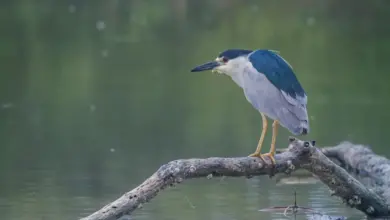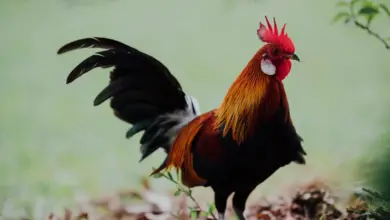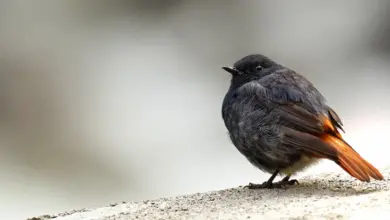Plain-bellied Emeralds
The Plain-bellied Emerald (Amazilia leucogaster) is a fairly common South American hummingbird. In Brazil, it is known as Beija-flor-de-barriga-branca.
Distribution / Range
The Plain-bellied Emerald occurs naturally along or near the coast in northeastern South America, from eastern Venezuela, south to around São Luís in northeastern Brazil, and west to Guyana, Suriname, and French Guiana.
Smaller disjunct populations occur in northeastern Brazil as far south as Pernambuco and Bahia.
They inhabit a wide range of semi-open habitats, primarily in coastal regions.
They are mostly found at sea level, in semi-open habitats, mangroves, along forest edges, cerrado, and caatinga ecoregions, plantations, parks, and gardens.
Even though they are not migratory birds, some post-breeding dispersal has been noted.
Description
The Plain-bellied Emeralds average 3.5 – 4 inches or 9 – 10 cm in length (including the tail).
The upper plumage and sides are glossy green, often tinged golden on the lower back. The throat and underplumage are white. The wings and tail are coppery bronze. The central tail feathers are golden and the outer tail feathers are dark blue with narrow whitish tips.
The bill is slightly curved. The upper bill is dark and the lower bill is flesh-colored with a dark tip.
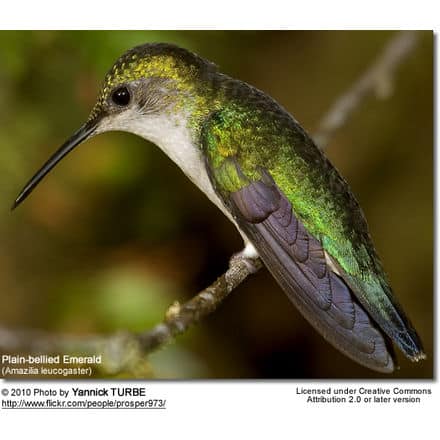

Nesting / Breeding
Hummingbirds in general are solitary and neither live nor migrate in flocks; and there is no pair bond for this species – the male’s only involvement in the reproductive process is the actual mating with the female.
Males court females by flying in a U-shaped pattern in front of them. He will separate from the female immediately after copulation. One male may mate with several females. In all likelihood, the female will also mate with several males. The males do not participate in choosing the nest location, building the nest, or raising the chicks.
The female Plain-bellied Emerald Hummingbird is responsible for building a small cup-shaped nest out of plant fibers woven together and green moss on the outside for camouflage in a protected location in a shrub, bush, or tree – oftentimes built low above water as protection from predators. She lines the nest with soft plant fibers, animal hair, and feathers down, and strengthens the structure with spider webbing and other sticky material, giving it an elastic quality to allow it to stretch to double its size as the chicks grow and need more room. The nest is typically found on a low, skinny horizontal branch.
The average clutch consists of 1- 3 white eggs (mostly 2), which she incubates alone for about 14 – 15 days, while the male defends his territory and the flowers he feeds on. The young are born blind, immobile, and without any down.
The female alone protects and feeds the chicks with regurgitated food (mostly partially digested insects since nectar is an insufficient source of protein for the growing chicks). The female pushes the food down the chicks’ throats with her long bill directly into their stomachs.
As is the case with other hummingbird species, the chicks are brooded only the first week or two and are left alone even on cooler nights after about 12 days – probably due to the small nest size.
The chicks leave the nest when they are about 20 – 25 days old.
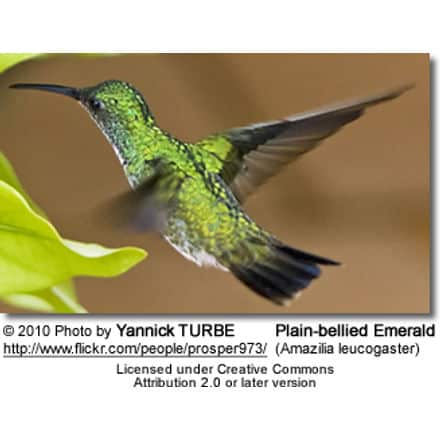
Diet / Feeding
The Plain-bellied Emeralds primarily feed on nectar taken from a variety of brightly colored, scented small flowers of trees, herbs, shrubs, and epiphytes.
Hummingbird Resources
- Hummingbird Information
- Hummingbird Amazing Facts
- Attracting Hummingbirds to Your Garden
- Hummingbird Species
- Feeding Hummingbirds

